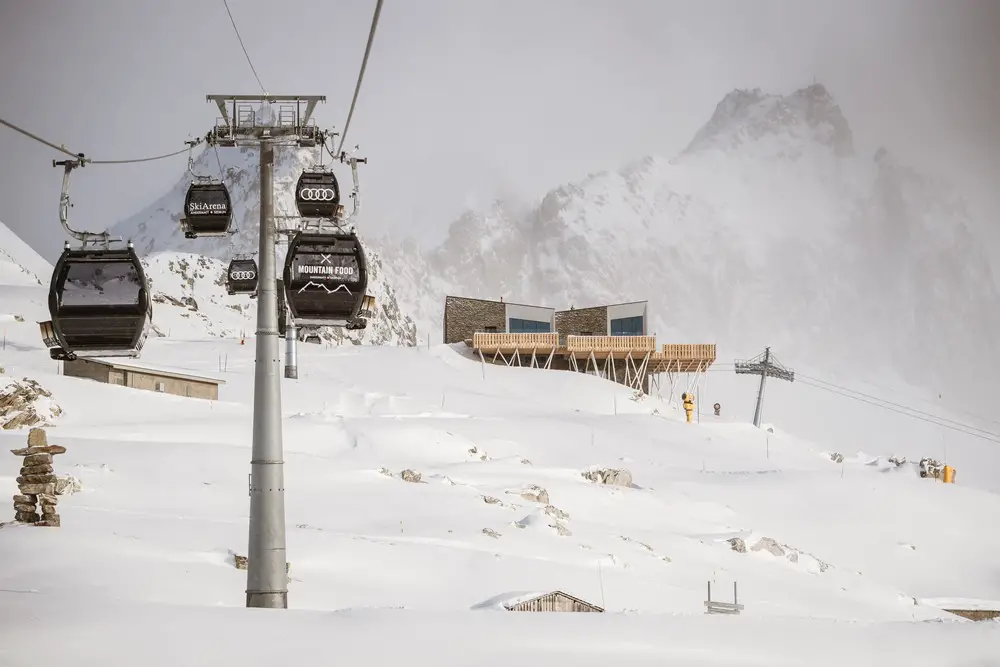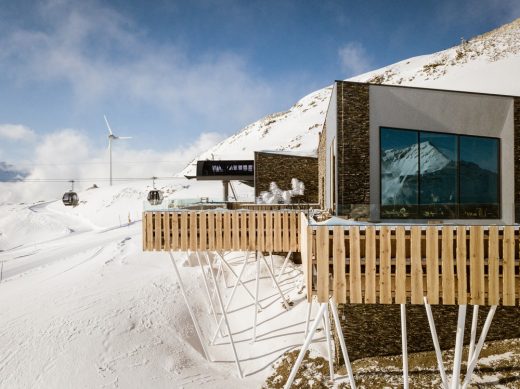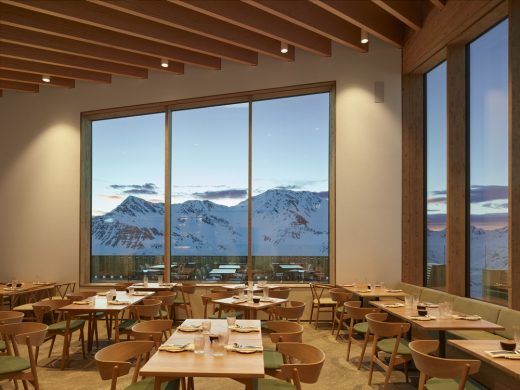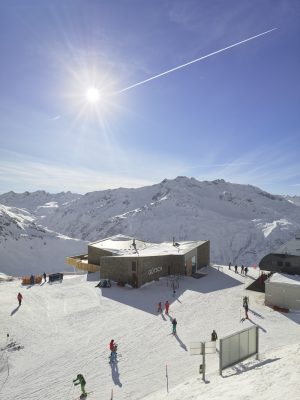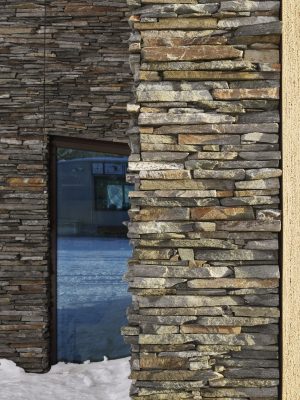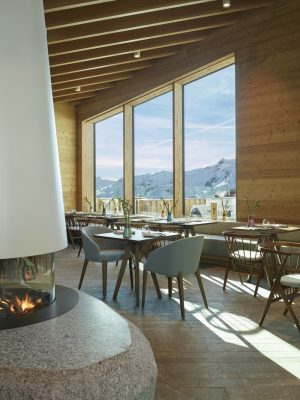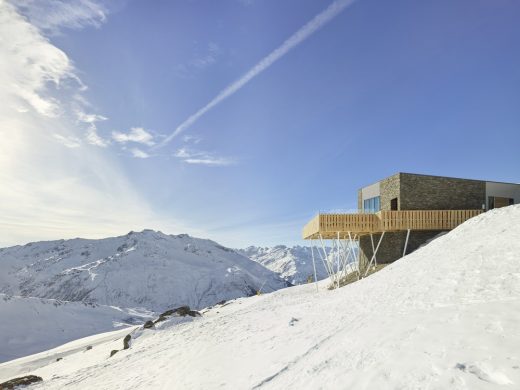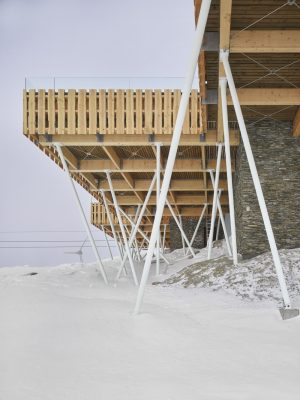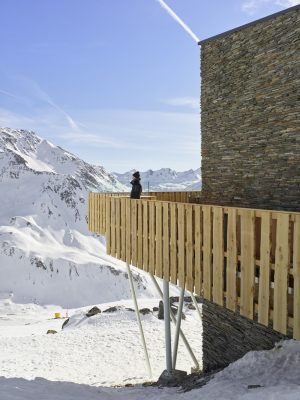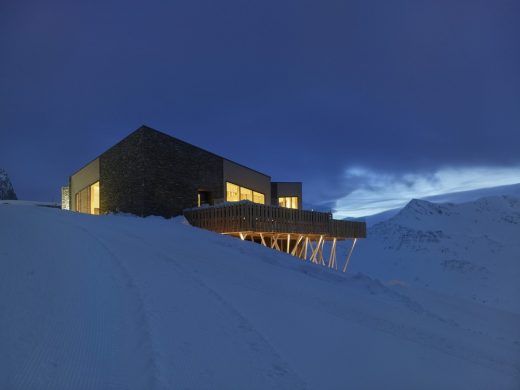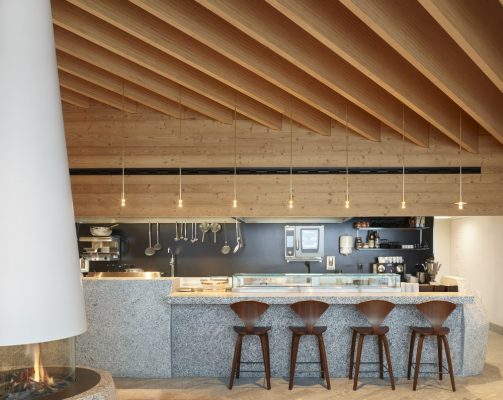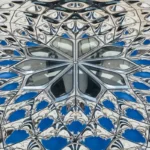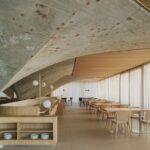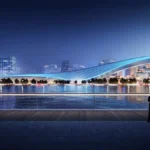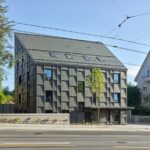Gütsch Restaurant Andermatt, Swiss Alps Architecture, Architect, Alpine Design Images
Gütsch Restaurant Complex, Andermatt
19 Apr 2020
Mount Gütsch Restaurants in the Swiss Alps
Design: Studio Seilern Architects
The Gütsch by Markus Neff
&
The Japanese by The Chedi Andermatt
Location: Andermatt, canton of Uri, Switzerland
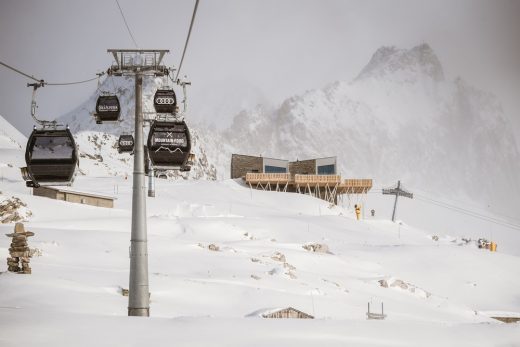
photograph © Valentin Luthiger
Studio Seilern Designs Two Fine-dining Restaurants On Top Of The Swiss Alps
• Studio Seilern’s second project in Andermatt following the opening of Andermatt Concert Hall in the summer of 2019
• Restaurant complex is located 2,362 metres above sea level, atop Mount Gütsch
Designed by London-based Studio Seilern Architects, the Gütsch restaurant complex, on top of Mount Gütsch in the Swiss Alps, was completed in December 2019 and will re-open in summer 2020.
At 2,362 metres above sea level, the 860-square-metre complex is home to two gourmet restaurants, The Gütsch by Markus Neff and The Japanese by The Chedi Andermatt, both boasting alpine architecture with large glazed panel walls, open fireplaces and breath-taking views of the Gotthard mountain panorama and the valley of Andermatt. The Japanese by The Chedi Andermatt has 44 seats indoors and 45 on the terrace. The gourmet restaurant The Gütsch by Markus Neff has 66 seats indoors and another 145 on two additional terraces.
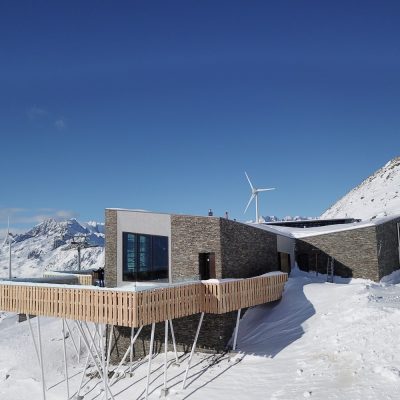
photograph © Studio Seilern Architects (SSA)
Inspired by the carved stone sculpture ‘Horta de Ebro’ (2003) by Manolo Valdez and the atmosphere and awesomeness captured in Caspar David Friedrich’s painting ‘Wanderer above the sea of fog’ (1818), Christina Seilern set out to create a landmark that is as robust as the dramatic setting of the landscape. Reflecting the silhouette of vernacular Swiss villages, the Gütsch complex is designed as a contemporary “hameau”, a Swiss hamlet, where a collection of smaller buildings create a harmonious whole. Due to the extreme weather conditions of the location, the construction process was split into two summer seasons. In addition to conventional transportation means, helicopters are used to transfer some of the materials to the site.
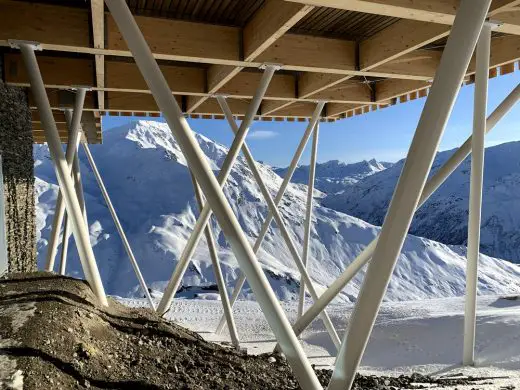
photo © Studio Seilern Architects (SSA)
The Gütsch restaurant complex is the latest highlight of Andermatt, a mountain village and municipality located in the canton of Uri in the heart of Switzerland. Following major development led by Andermatt Swiss Alps, the former garrison town of the Swiss Federal Army is transforming into one of the world’s finest year-round destinations. Facilities include a new village square, at the heart of which is the 700-seat Andermatt Concert Hall, also designed by Studio Seilern, inaugurated by the Berliner Philharmoniker in June 2019.
The Gütsch restaurant complex will serve skiers, hikers as well as guests of the hotels in Andermatt Valley throughout the year. The project was a finalist in World Architecture Festival Awards (2018).
Links:
The Japanese by The Chedi Andermatt
Andermatt, canton of Uri, Switzerland
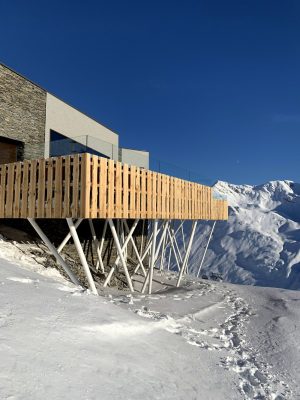
photo © Studio Seilern Architects (SSA)
Mount Gütsch Restaurant Complex
ARCHITECTURAL STATEMENT by STUDIO SEILERN ARCHITECTS
RESTAURANT BUILDING on GÜTSCH
The new restaurant building is at the heart of the developing Andermatt ski region in the Swiss Alps with a total capacity of 110 indoor and 190 outside terrace seats. Situated atop of the mountain at the interchange of two cable car lines, the building site is at an altitude of 2340m above sea level. It houses two first-class gourmet restaurants attracting both daytime skiers and dinner guests from the valley-based Grand Hotels.
INSPIRATION of FORM
The idea is to create a moment of inspiration by capturing the atmosphere and awesomeness of the altitude as in Caspar David Friedrich’s 1818’s painting, “Wanderer above the sea of fog”.
The mass studies took inspiration from the carved stone sculpture, ‘Horta de Ebro’ by Manolo Valdez and ‘Hameau’ vernacular Swiss Alpine villages; where several pitched roof houses sit against one another to form a cluster of stone walls and roofs nestled in a mountainous landscape.
The restaurant is made up of several pitched volumes sloping upwards with large windows opening up to the views beyond. It caters both for the aesthetic and the climatic challenges of a unique site and wide openings offer panoramic views over the valley of Andermatt.
The large balconies were attached to the anchoring stone volumes, creating a sense of lightness, as if floating over the landscape and the panoramic views. The idea was to create the same sensation of awe and excitement one gets when reaching the peak of a climb.
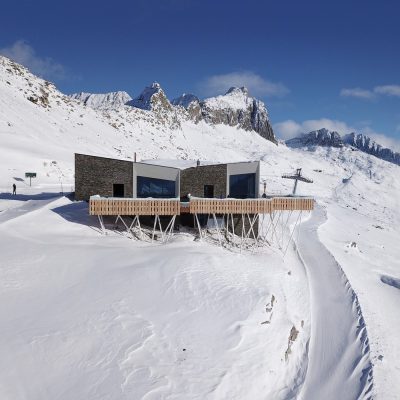
photograph © Studio Seilern Architects (SSA)
CONSTRUCTION CHALLENGES
Due to the extreme weather conditions in winter, there is only a short timeframe in summer that allows for construction. This is in part due to the closure of the road in winter which provides site access for delivery trucks. For this reason, the building is designed to be constructed in two Summer Seasons. In Summer 2018 the basement concrete structure was poured allowing for a speedier construction of the prefabricated timber walls and beams above ground in 2019.
The exterior façade is clad in stone, resembling the vernacular architecture of the area, with exposed timber beams and timber-panelled walls on the interior. A feature stone fireplace and sushi bar in the Japanese restaurant further tie the project back to the surrounding environment.
The logistics of designing a restaurant in such an isolated location have also had an impact on the design. Therefore, the need for large storage areas for non-perishable goods were designed due to the inaccessibility of the site for the delivery of goods during winter. In winter, only fresh goods will be delivered via cable car and then transported via ski-mobile to the restaurant.
SPATIAL DISTRIBUTION
The challenge of this project was to create a design that caters for both client groups, developing two separate restaurants under the same roof: The Japanese by The Chedi Andermatt and The Gütsch by Markus Neff. The building creates a landmark that is as robust as the dramatic setting of the landscape.
The restaurant is split into three volumes, each with their own use; the Japanese restaurant, the Gütsch restaurant and the kitchen, with the amenity spaces and storage, tucked into the basement level below. The solid stone volumes anchor into the ground, thus overcoming the steepness of the site and allowing a ribbon of timber terraces on steel columns to hover in front.
The roof structure is unique to each volume and follows the diagonal slope of the buildings. A series of beams span the entirety of each volume and define the characteristic of each dining room. The ancillary spaces are a maximum of 3m in height to allow for the beams to soar past and complete the volume.
The windows guarantee a constant view from the restaurant to the mountainous horizon. The viewpoint of the guest is always veered towards the outdoors and the size of the windows enable a blurring of the internal dining space and the external landscape.
The large terraces enable the capacity of the restaurant to increase on sunny days, with the potential for Après Ski. Late-night dinner guests will have the opportunity to come from their hotels via the cable car following the closure of the ski slopes to enjoy the isolated setting.
MATERIALITY
The base of the building consists of concrete foundations and base, with a prefabricated CNC timber structure on top allowing the building to be constructed in two seasons. The building is then clad in natural stone, in the language of the typical swiss ‘Hameau’ at high altitude.
The use of stone at higher altitude is to deal with excessive wind, frost, ice and snow which required a building material of strength and natural aging. We surveyed the local stone masonry walls built by the army over the years and wanted to adopt the same language, of a material sourced from the site, as if it was always meant to be there.
The balconies are purposefully made of a lighter timber material, to give it the sense of lightness and detachment from the main structure. The large panoramic windows have large bold frames, as if these were sculpted of the stone mass.
On the interior, a combination of steamed and roughened pine wood panelling and plasterboard is used. The ceiling consists of glulam beams, which can take the high live loads of snow accumulation during the winter months. The bar of the Japanese consists of a reconstructed stone sculpture, giving it an appearance of massiveness. In contrast, the white steel chimney hangs lightly from the ceiling. In the Gourmet, the bar is made of a colourful terrazzo, giving it its distinct identity.
Restaurant Gütsch, Andermatt – Building Information
Project Name: Restaurant Gütsch
Area: GEA 860m2
Altitude above sea level: 2,362m
Budget: 7M CHF
Project: 2015-2019
Construction: 2018-2019
Location: Gütsch, Andermatt, Switzerland
Client: Andermatt Sedrun Sportsbahnen AG
Architect: Studio Seilern Architects
Local Architect: Siebzehn13 Architekten AG
Project Team: Christina Seilern, Hana Potisk, Portia Malik, Jonathan Wrynne
Structural Engineering: Holzprojekt + IUB Engineering
Services Engineering: Qundqpunkt
Electrical Engineering: EWA
Building Physics Consultant: MEP
Fire Consultant: Holzprojekt
Lighting Design: Viabizzuno
Kitchen Planner: Alig Grossküchen
Key Manufacturers: Erni Holzbau AG, Gamma Bau AG, Patrik Langenegger AG
Christina Seilern
Principal, Studio Seilern Architects
Christina Seilern established London-based creative practice Studio Seilern Architects (SSA) in 2006. Applying her unique style across a range of building typologies, geographies and scales she re-engages in an approach that carefully addresses each project from an in-depth consideration of the detail to the overall massing strategy.
She tackles a range of projects from large scale city masterplans, down to the more intricate scale of furniture and light fitting design, both in the emerging and developed markets. Prior to establishing SSA, Christina Seilern was the founding director of Rafael Viñoly Architects (RVA) and was responsible for key projects such as 20 Fenchurch in London, the Curve Performing Arts Centre in Leicester, Mahler 4 tower in Amsterdam, and Wageningen University Plant Research Centre in the Netherlands. SSA was established with the intent of continuing the strong design ethos developed during Christina’s time at RVA.
In addition to the spectacular Gütsch Restaurant on top of the Swiss Alps, her diverse portfolio includes RIBA-award-winning projects such as Gota House in Zimbabwe, Ansdell Street in Kensington, a world-class concert hall in the Swiss alpine village of Andermatt, award-winning Wellington College Performing Arts Centre in Berkshire, Boksto 6 masterplan – a UNESCO heritage site in Vilnius, Lithuania and the Gouna Conference and Culture Centre in Egypt. She is a frequent panellist and guest speaker both in the UK and abroad and is also a regular juror for the AR MIPIM Awards, World Architecture Festival, the RIBA EyeLine, LEAF Awards and PAD London.
Studio Seilern Architects
Studio Seilern Architects is a London based international creative practice established in 2006 by Christina Seilern to produce exceptional architecture that lasts, working across geographies, building sizes and typologies. Studio’s diverse portfolio of built work spans the UK, Europe, North Africa and the Middle East with a focus on cultural, educational, residential and hospitality projects.
www.studioseilern.com
Andermatt Swiss Alps AG
From vision to destination: Andermatt has developed into a year-round destination in recent years, with apartment buildings, hotels and chalets, the Scottish-style 18-hole golf course, which presents golfers with a welcome challenge, and the SkiArena, which is not only one of the most modern ski resorts in Switzerland but also the largest in Central Switzerland, with pistes from Andermatt to Sedrun and Disentis. The 5-star deluxe hotel The Chedi Andermatt, with its perfect combination of alpine simplicity and urban sophistication, radiates a special magic, as does the Radisson Blu Hotel Reussen, with public indoor pool and wellness and fitness area. More apartment buildings and hotels will be built in the coming years.
Gütsch Restaurant Complex, Andermatt, Swiss Alps images / information received from Studio Seilern Architects
Previously on e-architect:
17 Mar 2017
Gütsch Restaurant in the Swiss Alps, Andermatt, canton of Uri, Switzerland
Design: Studio Seilern Architects
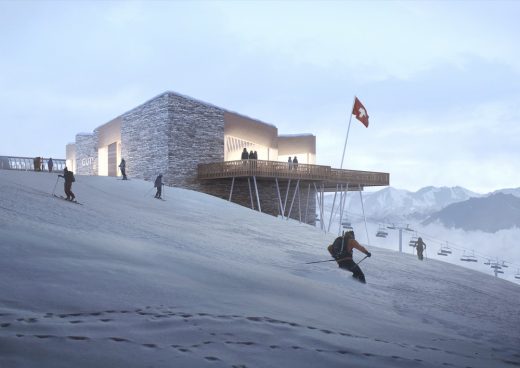
image courtesy of architects
Gütsch Restaurant
Location: Andermatt, Switzerland
New Swiss Architecture
Contemporary Swiss Architectural Projects, chronological:
Swiss Architecture Designs – chronological list
Andermatt Concert Hall Building, canton of Uri, Switzerland
Design: Studio Seilern Architects
Andermatt Concert Hall Building
Swiss Buildings – Selection
Hard Rock Hotel Davos Building
Design: Woods Bagot Architects
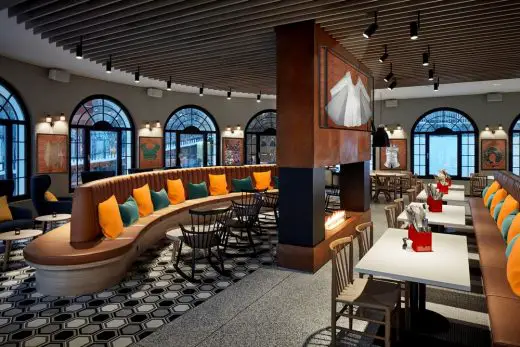
image courtesy of architects
Hard Rock Hotel Davos
Another design by Studio Seilern Architects on e-architect:
Jabi Lake, Abuja, Nigeria
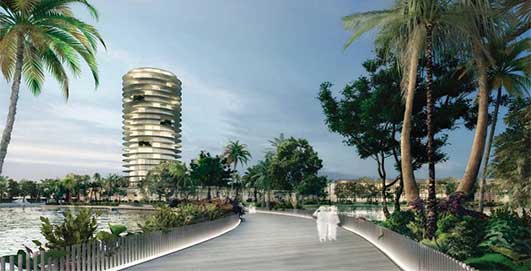
image © Studio Seilern Architects
Jabi Lake Buildings
Comments / photos for this Gütsch Restaurant Complex, Andermatt Swiss Alps Architecture page welcome
Website: Andermatt Switzerland

